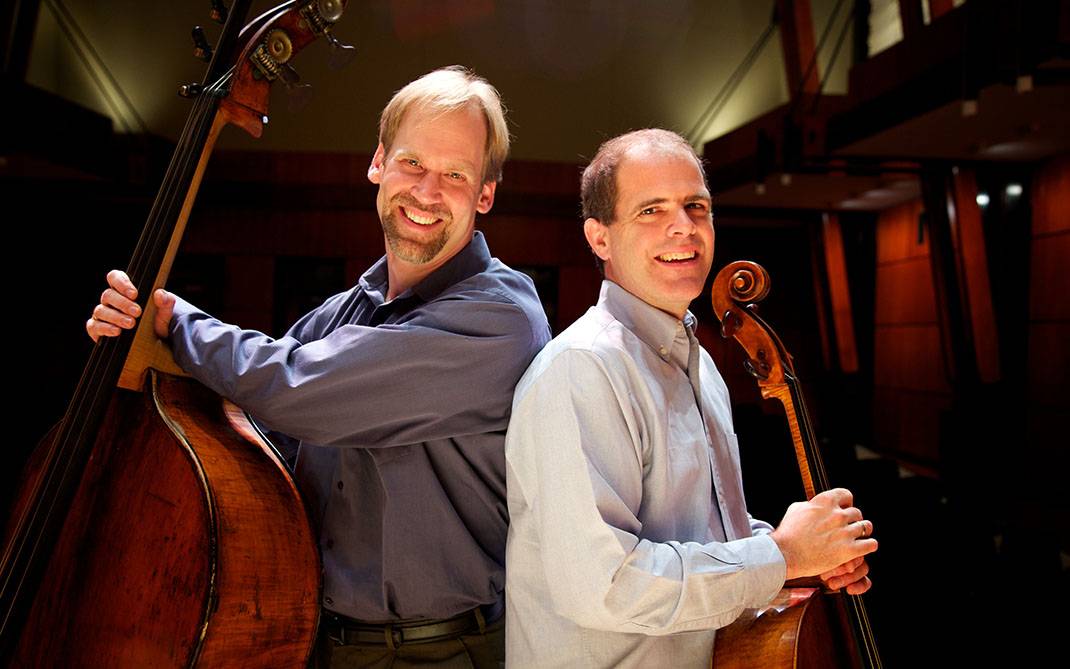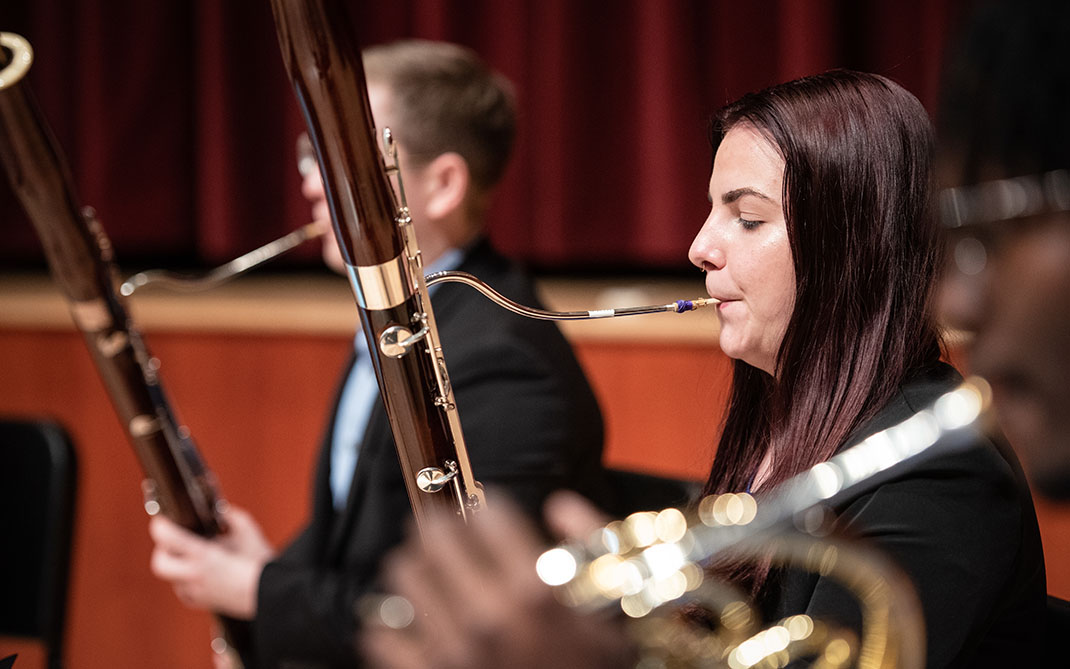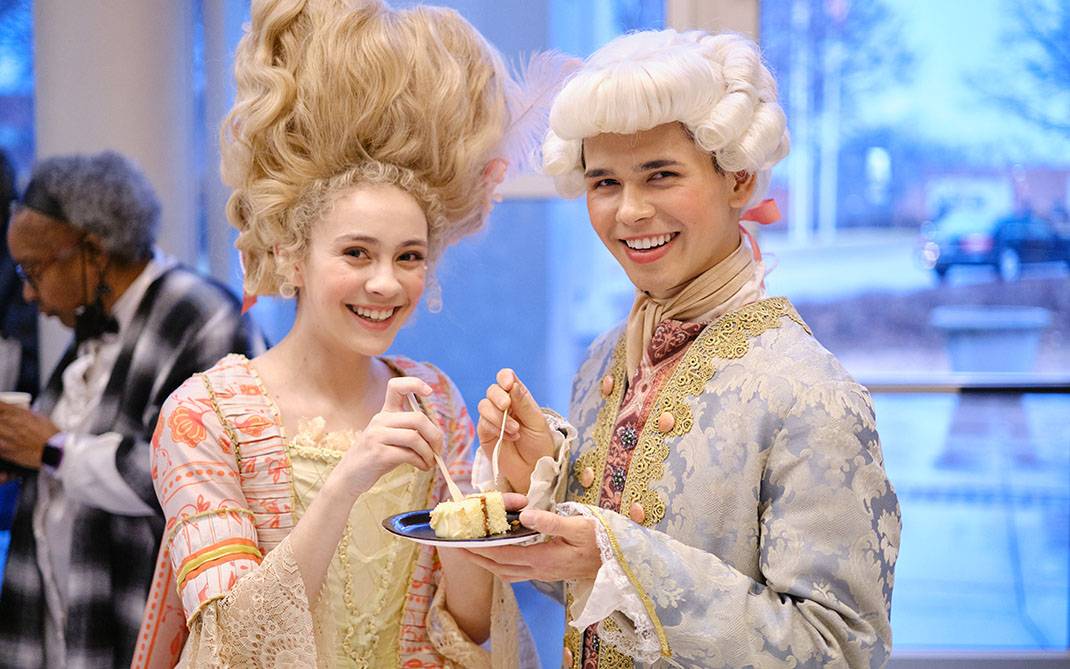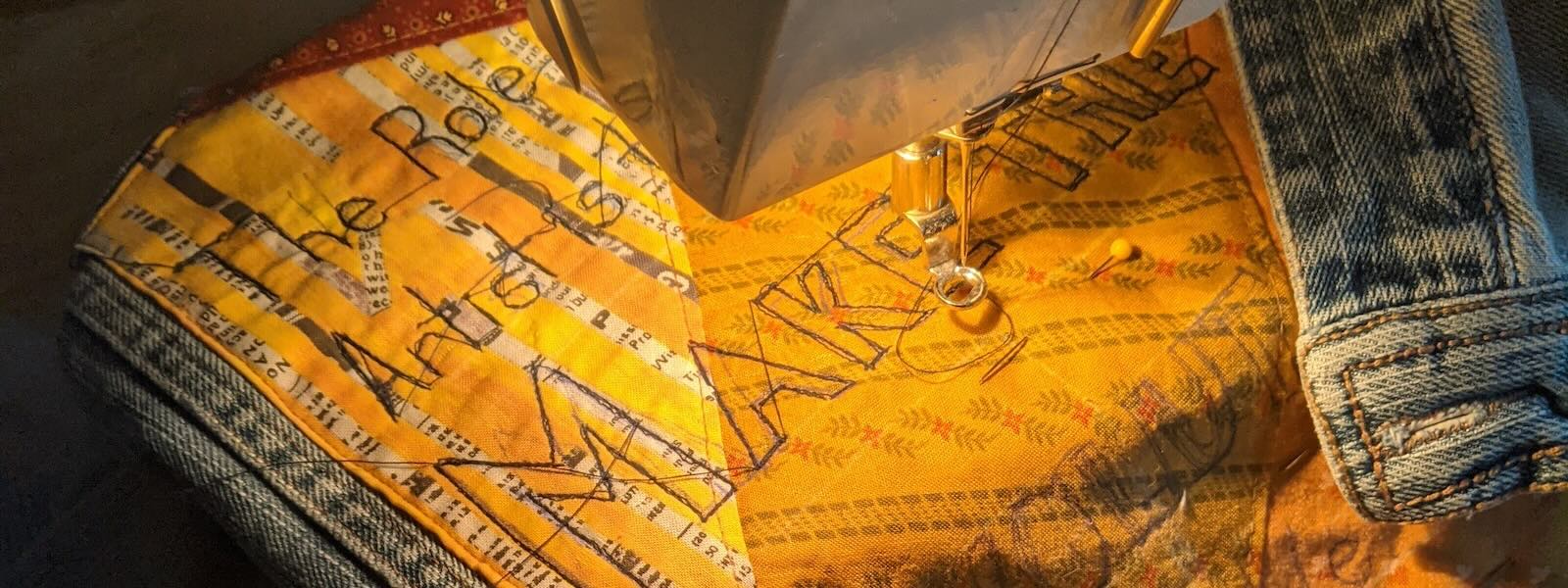Kristen P Ahern
Listen to the interview on Apple, Spotify, or your listening platform of choice. Captioned interviews are available on YouTube.
The views and opinions expressed by speakers and presenters in connection with Art Restart are their own, and not an endorsement by the Thomas S. Kenan Institute for the Arts and the UNC School of the Arts. This interview has been edited for length and clarity.
Costume designer Kristen P Ahern has been thinking about sustainability since childhood, when her parents, her mother in particular, instilled in her a passion for environmental responsibility. As an adult, she has centered that passion in her art, in 2018 founding Conscious Costume, an information-and-resources clearinghouse with a clear vision: “Every costume created in harmony with people and planet.”
Although Kristen now lives in Pittsburgh, PA, she still has deep roots in Chicago, where she designed for several theaters and also managed a few costume shops in the area. Chicago is also where Conscious Costume’s costumes-rental facility continues to operate, giving area designers and theaters greater access to reusable materials and costumes. It is also in Chicago that Kristen, during the COVID-19 pandemic lockdown, created Artist Resource Mobilization (ARM), an organization that matched out-of-work designers and costume-shop artists with mask-production opportunities. In the pandemic’s most dire year and a half, Artist Resource Mobilization was able to provide garment artists with $35,000.
In this interview, Kristen explains what responsible costume design and production entails and offers a primer in how designers and costume shops can take small-to-large steps to ensure they protect the well-being of their onstage and behind-the-scenes artists as well as the environment.
Choose a question below to begin exploring the interview:
- At what point in your career did you realize there was a more sustainable way to do the work that you’re doing?
- How did you start putting your conservation ethos and your ethical ethos into practice?
- Tell me about founding Conscious Costume. What was the impetus for that?
- What impact do you think it’s had so far? What are you hearing from your colleagues who’ve used it as a resource?
- What do you want to share with us about the clothes we wear and, other than buying secondhand, of course, the ways in which we could be more sustainably minded in choosing our clothing?
- Could you describe an environmentally responsible costume shop?
- Do you ever face resistance from your directors or producers? Is there a big economic downside to what you’re proposing?
- Does the ethically conscious part of your mission also include labor practices within the U.S. theatrical field and the way that the labor in costume shops is managed?
- Are you hearing from scenic designers and lighting designers that they too are interested in sustainability in their own fields?
- If you had the power to snap your fingers and change one status-quo system in the theater world regarding costume design and the people who build costumes, what would be at the top of your list?
- What’s next on your artistic plate?
Pier Carlo Talenti: At what point in your career did you realize there was a more sustainable way to do the work that you’re doing? Was there an aha moment?
Kristen P Ahern: I think for me it’s always been a part of my practice. The aha moment that is in my brain as my origin story, I like to say, is I was working on a show in undergrad and we had this, to my mind, very expensive fabric. It was like $24 a yard, which as a young designer seemed so expensive.
Pier Carlo: Was it a period piece?
Kristen: Yes, it was “Così fan tutte,” the Mozart opera, and we were doing it in a mid-19th century era. I wasn’t the designer; I was just working in the shop at the time. There were scraps of this fabric in the garbage can, and I remember someone dumping their leftover Cup O Noodles on it, and seeing it destroyed just broke my heart. There were many opportunities like that that I saw where I was like, “Ah, this is waste, but could we conserve it?” But the issue always comes down to space. I think every shop figures out, “We’re not going to save pieces smaller than this because we’ve just determined that it’s not worth it.” So that was really thinking about the waste side of things.
Then early in my career, I was assisting a designer named Elsa Hiltner quite often, and she really turned me onto the exploitative labor practices in the fashion industry. Starting to see myself as a participant in that system, I really began educating myself on the complexities of fashion supply chains, waste and where I fit into it.
Pier Carlo: So let’s talk about how you do fit into it. How did you start putting your conservation ethos and your ethical ethos into practice?
Kristen: I think by default, in a lot of early-career productions, there’s no labor support, there’s small budgets, so you’re thrifting and borrowing and being creative with materials just by necessity. One of my first shows was with a small theater company in Chicago called Filament Theater, and sustainability was a part of their ethos. In my contract it said that I had to spend ... I want to say it was 75% of my budget on sustainable materials. That really inspired me to start putting actual numbers to —
Pier Carlo: And also it makes you want to figure out how to determine if a fabric or material is actually sustainably sourced.
Kristen: Yeah. And that’s a really fascinating question. One of the things I try to do with Conscious Costume is acknowledge that there are many, many ways that one can be sustainable.
This was a new thing that Filament were doing, so it wasn’t like they were going to dock my pay or anything. It was just like, “Hey, try to do this.” So for the most part it was secondhand. I consider anything secondhand to be sustainable. Now, there are secondhand things that are more sustainable or less sustainable. If it’s manufactured and is high quality, it will sustain for longer as opposed to something that you maybe thrift that is a very low quality.
Pier Carlo: That’s what they call fast fashion, right?
Kristen: Right, exactly. Fast fashion. There’s a lot of different ways to look at it. With Conscious Costume, inspired by this, I do something called My Conscious Budget, where I look at a lot of different frameworks for sustainability. So secondhand is just one; organic-manufactured or recycled materials is another; just shopping at a small business is more sustainable than buying that same thing from a big box store. Not everybody has access to the same resources, but I think that there’s always an angle that you can take that goes, “How can I do just a little bit better with my budget?”
Pier Carlo: Can you give me an example of a time when you felt you were particularly resourceful in meeting your goals?
Kristen: Hm, that is an interesting question. I was the designer and costume director for a burlesque company in Chicago for a little while, and we did exclusively parody burlesque. So a parody of “Star Wars” as a burlesque show, a parody of “Star Trek” as a burlesque show, “Lord of the Rings,” etc.
Pier Carlo: [Laughing] I was going to say burlesque, it’s about taking the clothes off. The clothes in a way are not important, but this sounds like expensive burlesque.
Kristen: It was, yes. And, well, I think the clothes are deeply important because you have to think about every moment and every layer, and it’s got to come off when you want and not too early and not be a struggle for the performer onstage. There’s a lot that goes into it. But we had very small budgets. I was trying to thrift as much as possible, and I earned the nickname The Thrifting Queen because I was really able to be very successful shopping for things for those productions.
And I’m thinking back to also a design that I did for a college production of “Nine to Five” a few years ago. There are these dream-ballet moments, and for the Dolly Parton character, we wanted all the backup dancers to be square dancers and find square-dancing skirts all in red for them. I was shopping mostly secondhand online, and I was able to put together a really cohesive background-dancer scene that didn’t look like every piece was thrifted. It looked really thoughtful, just by having a really clear eye of what I needed and learning the different search terms that would get me what I was looking for across different secondhand online-shopping platforms.
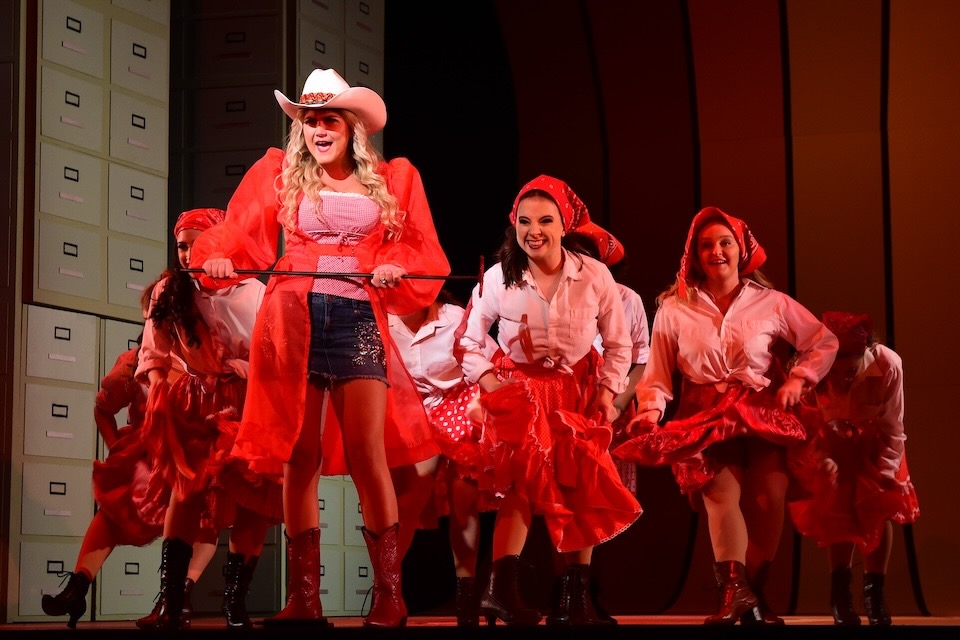
Costumes for “9 to 5 The Musical” by Kristen P Ahern, The Catholic University of America, 2019. The ensemble costumes were sourced second-hand from thrift stores and online resellers.
Pier Carlo: Tell me about founding Conscious Costume. What was the impetus for that?
Kristen: When I was first starting out, I was looking for sustainable costume-design resources, and there just weren’t any out there. There were things for fashion, but even that was a little thin, so I was looking for these resources. I really built Conscious Costume to be the resource that I wish I had, mainly about spreading the word of the importance, spreading resources, building community. I knew other people were talking about sustainability and were interested in it, but there was no central location to have these conversations.
It started just as a Facebook group. The day of the Tony Awards in 2018 is when I started the Facebook group.
Pier Carlo: That’s easy to remember.
Kristen: Yeah, and I hoped that by starting it then a lot of people would be talking about theater and be active on Facebook those couple of days. I was hoping to capture some people that way, and that did kind of work. Really it just started as a place to have conversations and share ideas.
It wasn’t until a couple of years in that I got an Instagram and a page and that we started working as a nonprofit with the Apparel Industry Board, Inc. (AIBI), which is our parent organization, and really tried to turn this into more than just a community. But the community is also really active. I’ve learned a lot of things about how broad the sustainable-and-ethical-design community and world are, and I’ve learned so much from others in the group. A costume design professor out of North Carolina, Rachel Pollock, talks a lot about water conservation in the costume-dye process and how she saves hundreds of gallons of water, especially during a drought in her region. And so much more that I’ve learned from the community.
Pier Carlo: It’s been fully active, what, six years now?
Kristen: Yeah, about six years.
Pier Carlo: Tell me about what impact do you think it’s had so far? What are you hearing from your colleagues who’ve used it as a resource?
Kristen: I think everyone is glad to have somewhere to commiserate, if nothing else, just to share frustrations at the limitations that we all have to deal with. I think a community is good in so many ways. I have heard from people who have learned things from the community. I have another designer who does a lot of work with natural dye, and she contributed to a couple of blog posts on our website. So I think the community is the main thing.
Now we also started a costume-rentals or what I like to call rentals-and-recycling in Chicago while I was there, and people really appreciate the resource. Our pricing’s intentionally low so that it’s really accessible for people. We try to make it so there’s fewer hoops to jump through.
Pier Carlo: So there was a business connected to it then?
Kristen: Yes. Yes.
Pier Carlo: Did you have a brick-and-mortar space? Clearly you must have had some storage.
Kristen: Yep. We share a space with our parent organization, AIBI, and that’s still there. When I left Chicago, we hired a rentals manager, Emma, who’s doing a beautiful job maintaining the space, working with the Chicago Green Theater Alliance (CGTA) on costume swaps once a year. She’s doing so, so much.
Pier Carlo: What’s a costume swap?
Kristen: It’s where theaters and designers come together, bring costumes they don’t want anymore and take costumes that they do want.
Pier Carlo: That’s brilliant. How long has that been going on?
Kristen: We’ve been doing it with them since about 2020 or 2021. I don’t remember when the first one post-pandemic was. CGTA has been doing them for I think 10 years, 12 years. They’ve been doing them for a while.
Pier Carlo: At this point, you must know so much about the way fabrics are created. What do you want to share with us about the clothes we wear and, other than buying secondhand, of course, the ways in which we could be more sustainably minded in choosing our clothing?
Kristen: It’s so broad. It’s so broad.
Pier Carlo: But there must’ve been something you learned that you didn’t know before your recent work.
Kristen: Yeah, absolutely. I would say look into the labor practices of where you’re purchasing from. Make sure that people are being paid a fair wage at a minimum. A living wage or a thriving wage would be even better.
Pier Carlo: Because there’s a lot of layers to finding that out for real. How do you do that research?
Kristen: I usually start with a brand that I know is ethical, and there’s places that you can find those brands. One of them is called Good On You. Another is the Clean Clothes Campaign, and these are all listed on Conscious Costume’s resource page so that people do know where to start finding some of those things. I am also putting together a sourcing list. I’ve had one that I’ve been keeping for about 10 years that I just, when I happen to find a resource that I think might be useful to other people, I put it on this list. That’s also on Conscious Costume’s resources page. So that’s a place to start.
I think organic materials and recycled materials are great. Buying natural fibers is going to be better than any synthetic fibers like polyester or nylon because those are plastic. I think a lot of people in the last year or two have become more familiar with the problem with microplastics. Well, there’s also microfibers coming off of your clothes every time you wash them, and if they are a polyester, then that’s going into our waterways and that’s not going to break down. That’s some of the stuff that the fish eat, and then we eat the fish, and then that is how microplastics get into our blood. It’s amazing how much that circle comes back and impacts us.
I would say I try to exclusively buy natural fibers. I also feel more comfortable in them because I’m not wearing plastic. I’ve just noticed a change in how I feel in those fibers. So if you do have a lot of polyester ... leggings are a pretty common item that’s polyester. Athletic wear.
Pier Carlo: Oh, right, because it’s got that spandex, that stretch factor.
Kristen: Exactly. If you do have a lot of those clothes, you can get filters for your washing machine, either like a bag that you put the polyester clothes in or something that you attach to your washing machine, that will filter out those microfibers to a high degree so that you can just throw them away. Then they will go into landfill, but they don’t go into waterways. I think that’s something that normal people can do. I think that the bag that I have was like $40 or $50, but I’ve had it for five years now, and it’s showing pretty much no signs of wear.
I think that that’s something that costume shops can do as well, to get a filter for their washing machine. That’s a huge step to eliminating a sustainability problem.
Pier Carlo: We’ve talked about your work as a designer being more ethical and environmentally conscious. Could you describe an environmentally responsible costume shop? You mentioned that there’s limited space, so that’s already one challenge.
Kristen: Yeah, for sure. I just mentioned the microfiber filter to the washing machine. Two years ago, we did a blog post called “A Costume Professional’s Guide to Plastic-Free July.” Plastic-Free July is a social-media push to educate on plastics every year, and so we’re trying to make that accessible to costume designers. The microfiber-filter links to a couple options are available in that blog post.
But other norms include a textile-recycling plan, be it for the clothes you’re getting rid of or your fabric scraps. Unfortunately, thrift stores, which a lot of people rely on to get rid of the things that they don’t want, only resell about 10 to 20% of what they receive, and the rest goes to rag makers or shipped to the global south where the piles of unwanted clothes are now visible from space. So really coming up with a thoughtful textile-recycling plan.
Other norms in shops that I’d love to see: allowing actors purchase costume pieces, because then it’s going somewhere that someone’s going to use it versus if you’re going to hang onto it for a show that might happen in 10 years. Is that the best use of your storage space when somebody is saying, “I would like to buy this thing”?
Pier Carlo: “And I will actually use it.”
Kristen: Exactly, exactly. “I love it. This has become something that is a memory of the show, and I know these pants were tailored to me, and they fit me, and I want them.” I think it’s a great way to keep things out of your stock and keep them in use.
I think being creative about mock-up materials. The industry norm is to buy this clean cotton muslin for every mock-up, and maybe you could buy secondhand dead stock fabrics, thrifted bedsheets, etc. It’s maybe not going to be a fit for everything, but every little bit helps is my perspective.
We already talked about natural fibers, and I think of being more conscious about those materials that go into garments that are unrelated to design choices. So cotton undershirts, which pretty much the whole cast will wear. Can you source an organic cotton? Can you source an ethically manufactured undershirt? Can you maintain them for a longer time through your practices rather than, well, this was worn for one show and now it’s garbage? At the end of their life, could you cut the undershirts up into rags for cleaning to cut down on paper-towel use, etc.?
We talked about polyester. That’s another one, really eliminating polyester anywhere you can look. Minimizing dry cleaning. Perc chemicals that go into dry cleaning are really damaging to the environment. They’re damaging to the workers of the dry cleaners. They’re bad for the actors who wear them only hours after being cleaned. That off-gassing contains volatile organic compounds that can be really bad for people. So really minimizing that dry cleaning or finding a green dry cleaner. There’s ones that have alternative processes now. Unfortunately, a lot of places advertise that they’re green dry cleaners, but if they don’t talk about what is greener in their process, then I assume it’s just green-washing, and I ignore it.
That goes back to the question you asked about how to find a brand. If you are on a brand’s website and you look for their sustainability page, if they don’t have one or they don’t say anything specifically and they just use buzzwords like natural or clean, those words are meaningless unless they say more specifically what they’re doing.
Pier Carlo: Yes. It’s like in the supermarkets with products that use the word natural. It’s meaningless.
Kristen: I compare clothes-shopping to food-shopping a lot because you have to think about a lot of the same things. A lot of times organic produce or organic cotton, they don’t use chemicals, they don’t use the pesticides, but they tend to be more water-intensive as a result. So if you are in a really drought-prone area, maybe organic is not your best bet. Maybe a low-water-use is a more sustainable option. Like I said, it can be really complicated, and there’s lots of layers to look at.
Pier Carlo: Did you grow up with this interest in sustainability? Clearly, it’s almost in your DNA. It’s in your bones. Where did it come from?
Kristen: I definitely have to credit my parents, especially my mom. She was in Ecology Club in the '70s and that first wave of really pushing recycling. I was not allowed to have individually packaged bags of chips in my school lunches when I was a kid, and so I think that some of this was always built in. My grandparents lived through World War II and so really ingrained in me that belief in saving everything, washing plastic bags, that sort of thing. I just extrapolated it from there.
I’m really active in my local buy-nothing group and circular economies, learning about labor practices, just taking it to that next step of, "I think everybody wants to live a happy and healthy life, and we need to protect the natural systems that support a happy and healthy life." It just makes sense to me to think this way, and it blows my mind that some people default to exploiting others. I’m not saying that the average consumer is actively exploiting other people, but we are built on systems that rely on exploiting people or exploiting landscapes to get us what we want, and that feels so unnatural to me.
I’m not saying that the average consumer is actively exploiting other people, but we are built on systems that rely on exploiting people or exploiting landscapes to get us what we want, and that feels so unnatural to me.
Pier Carlo: Turning back to the costume shops and clothing design, because I know you often have to work with really tiny budgets and you’re expected to spin magic out of these budgets. Do you ever face resistance from your directors or producers? Is there a big economic downside to what you’re proposing?
Kristen: I think the biggest issue is that it takes more time. And I absolutely encounter resistance.
Pier Carlo: More time because of the sourcing?
Kristen: Yes, generally because of the sourcing. That resistance and the friction is part of the reason I’m more focused on educating others right now than doing the design myself. I’m a bit of a perfectionist. I’m neurodivergent, so I can get really obsessive about the sustainable and ethical choices, and that negatively impacts the shop staff and the production process because I take a really long time to —
Pier Carlo: Oh, so you’ve come to realize that?
Kristen: Yes, I have realized this about myself. [She laughs.] So right now, education is really what I’m pushing for. I would love to do more work with companies or on productions that are intentionally ethically minded rather than me just tacking that on the side, because I think if we all had that mindset, it would be really helpful.
I worked on a production recently where, knowing that I take a little bit more time than the average designer, I asked to see the stock very early in the process, and the shop manager was really resistant to that idea because the show hadn’t been cast yet. I wasn’t done designing; why would I need to see the stock? So I think it is asking people to change up the norms and back up their standard production process. But I knew if I saw the stock and had an idea in my head of what I was working with, that might impact the decisions that I was going to make.
Pier Carlo: Were you able to do it, or did you pull back in that instance?
Kristen: I did decide to pull back on that instance. It was a shop I hadn’t worked with before, and I was trying to not ruffle feathers. And that can be really challenging, deciding when to push and when to pull back.
Pier Carlo: We’ve talked about the ethically conscious part of your mission being about labor practices, certainly in the production of materials, but does it also include labor practices within the U.S. theatrical field and the way that the labor in costume shops is managed?
Kristen: Yeah, absolutely. Anyone interested in that, I highly recommend looking into the work of Costume Professionals for Wage Equity or, on the film side of things, look into #NakedWithoutUs. Both of those are pushing for labor equity and pay equity within costumes. So not only are costume designers typically the lowest-paid designers on a production —
Pier Carlo: I can guess why. Can I guess why?
Kristen: You can guess why.
Pier Carlo: It’s to do with gender.
Kristen: It is to do with gender. It is what we call a pink-collar job. Historically garment workers make less than our counterparts in other fields. I have seen theaters advertising entry-level internship jobs in their scene shop and in their costume shop, and the costume shop one will be paid a dollar or two less per hour than the scene shop one. When challenged about that, they just go, “Well, this is what we’ve always done,” which is really a sentence I hate. [She laughs.]
But I also think the other reason that I like the word ethical is, is there actually an ethical way to pollute a river? It is about the people, but it’s also about the environment. I think there’s no ethical way to knowingly damage the environment.
Pier Carlo: Going back to design, are you hearing from scenic designers and lighting designers that they too are interested in sustainability in their own fields?
Kristen: Yeah, absolutely. I hear from designers all over the spectrum and technicians, practitioners in whatever realm, that they’re interested in this as well. There’s the Chicago Green Theatre Alliance, which is made up significantly of designers, technicians, administrators. Relatively, the people that I know aren’t on the performance side of things; they are a lot of the offstage things.
Reuse is a big part of the conversation when it comes to set and props. When it comes to things like lights, it’s about the instruments and reducing how much energy the instruments draw down, lowering the carbon footprint that way. And also sharing equipment. Instead of buying a new piece of equipment for a show, how can I use something that maybe my friend has? Or how can I redistribute this unique item that I bought for a show that I only need for this one show and get it out to somebody else?
The Chicago Green Theatre Alliance Facebook group is a huge year-round materials-swap and equipment-swap that people are always posting, “Hey, we strike next Sunday. Here are the things we’re getting rid of. Set up a time to come grab.”
Pier Carlo: That’s fantastic. And it really just cements the community even more.
Kristen: Yeah, absolutely. [Laughing] I’ve met more people doing that than I think I have on shows, which is great. I think it’s because we all look at something that we spent two months building, and we don’t want it to go into a dumpster. We don’t want it to go into a landfill. We don’t want it to just get tucked in a corner of stock where it’s going to fall off the hanger and get stepped on. We see the value in these items and, I think, want them to get used.
Pier Carlo: If you had the power to snap your fingers and change one status-quo system in the theater world regarding costume design and the people who build costumes, what would be at the top of your list? What would you magically change and how?
Kristen: I think it would be the thing I was just talking about, borrowing or loaning or reselling costumes or other theater items and really focusing on circular thinking. Right now, we have linear thinking or a linear economy where something is made, it is used and then it is disposed of. Circular thinking starts to disrupt that, where something is made, it is used and then it is remade or reshared or goes back into the top of the funnel somehow.
In 2021, my colleague Amy Sutton and I won the San Diego Opera Hack with an idea for an app that would facilitate sharing of theater materials, so they thought it was a good idea too. I think this is something that interests a lot of people. Unfortunately, it was a token prize money, which was lovely and appreciated but not enough to develop the technology. Developing an app is very expensive.
For a little while, we were working with the Theatre Green Book, which is out of the U.K., and the Canadian Green Alliance, which is another green theater alliance, to find additional sources of funding, possibly government grants in the U.K. or Canada. The U.S. doesn’t have government grants for this type of thing unfortunately. A few months ago, a similar platform came out in the U.K. called Pursued by Bear. I’m in contact with the person who developed that app, and hopefully we’re going to be able to connect here in the not-too-distant future because he built something that is really similar to what we were thinking. It’s just only available in the U.K. right now.
So yeah, I would really love for some tool to facilitate that borrowing/reselling/loaning process, because I think a lot of people would do it. It just comes down to time.
Pier Carlo: Finally, what’s next on your artistic plate?
Kristen: I’m really taking 2024 for two things, and the first is focusing on Conscious Costume, specifically on Conscious Costume’s cash flow. I would love for that to be my full-time job.
Pier Carlo: What does that entail?
Kristen: In terms of improving our cash flow?
Pier Carlo: In terms of getting more cash flow.
Kristen: Right now we have our rentals manager, who I mentioned, in the space that we’re paying for, and that’s all our budget is going to. So that’s the fees for the rentals; it’s some grant support out of Chicago; and we do have a Patreon that gives us a small monthly income. So those are the three things right now that are making our income.
I would love to get more rentals out there. I would love to get more people interested in supporting some of the research I’m doing through the Patreon because I would love to spend more time really focusing on creating new resources, but that has not been a high priority because I am just trying to keep afloat right now. But there’s a lot of writing projects or video projects that I have cooking around the back of my head that I would love to do when I have the time and resources to do them.
Then the other thing that I’m focusing on is my personal approach to creativity and design. I’ve been doing some upcycling projects for clothes that I’ve had ideas for for a while, creating art with upcycled textiles. I have a lot of small pieces from mask-making with ARM. Last year I had a piece in a gallery show, and I also donated a piece to Planned Parenthood’s fundraiser that had a quote from the original Roe v. Wade decision embroidered on it. So that’s been my personal approach to art. I really do want to get back into a theater setting, but like I said, I think it’s got to be a production where the sustainability is a part of the whole process, not just my thing. Because I will shoot myself in the foot, and that’s not good for my mental health.
The other thing that I’ve been working on this year is I’m working on my permaculture-design certificate. Permaculture is really about design-and-systems thinking in an agriculture setting or in a garden setting. It has just really fit into the way that I think about the artistic ecosystem and that circularity. There’s three ethics in permaculture: earth care, people care and fair share. It fit into the ethos that I was thinking about. It felt like I found my people.
One of the things I like about costume design is it’s a puzzle of how do you make everything work within the design constraints, and permaculture is giving me that same puzzle approach of limited resources, limited budget, limitations within the sun and the rain here in Pittsburgh and the space that I have. It’s just given me a different way to stretch some of those skills.
I’d really love to at some point do a class or an article or a video on how the permaculture ethics-and-systems thinking can apply to performing arts and entertainment because I think that this ecosystem thinking and this collaborative thinking is the main solution to being able to be more sustainable as an industry.
August 12, 2024
